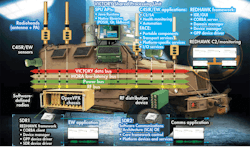Military and avionics systems often require custom solutions because of their cutting-edge requirements. The trend to use commercial off-the-shelf (COTS) systems is intended to expand the number of options available to designers while reducing costs. The VITA VPX standards address much of this in terms of hardware, but these days software costs are often greater.
On that front, the three U.S. service research groups—Army CERDEC, Air Force AFLCMC, and Navy NAVAIR—have been working on additional hardware and software standards. These are now being integrated to provide common frameworks that can be used to acquire new materials and software (Fig. 1). Though the alphabet soup of projects is large, they’re all being built on industry standards like VPX.
1. Multiple, layered standards including CMOSS and SOSA are being applied to new systems design for military applications.
Still, the new standards face significant integration challenges, including competition for limited platform resources; redundant subsystem components; complex, costly and weighty cabling; excessive heat generation; and less space on the platform for soldiers. There are major RF compatibility concerns, too, due to the large number of diverse systems already in the field. Likewise, the high cost of maintaining and upgrading systems must be addressed.
One central project is the C4ISR/EW Modular Open Suite of Standards (CMOSS). It’s an aggregate of many existing projects plus new and existing standards such as Vehicular Integration for C4ISR/EW Interoperability (VICTORY), Modular Open RF Architecture (MORA), OpenVPX, REDHAWK, Software Communications Architecture (SCA), and the Open Group’s Future Airborne Capability Environment (FACE). NAVAIR’s Hardware Open Systems Technology (HOST) is also part of the mix, although a segment of the overall design-integration process will merge HOST and CMOSS. CMOSS is now part of, and managed under, the Sensor Open Systems Architecture (SOSA).
2. The Sensor Open Systems Architecture (SOSA) group intends to deliver a set of technical and business reference architectures, IP business case, acquisition strategy document, and request for proposal (RFP) technical package.
The systems take a layers approach, building on existing hardware and software standards like OpenVPX and Data Distribution Service (DDS). The end game for SOSA (Fig. 2) is “delivery of a set of technical and business reference architectures, IP business case, an acquisition strategy document, and a tailorable request for proposal (RFP) technical package.”




